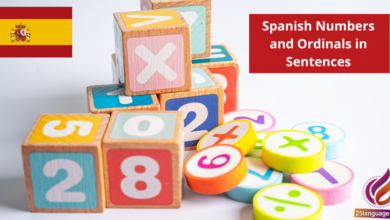Spanish Possessive Pronouns

Imagine effortlessly expressing ownership in Spanish, just as you do in English. This lesson unlocks the world of possessive pronouns—mío,tuyo,suyo,and more! Mastering these words will elevate your conversational skills and allow you to convey relationships and possessions with clarity and precision. Get ready to enhance your Spanish vocabulary and confidence as we explore how to use these powerful pronouns in everyday situations. Let’s dive in!
Mastering Spanish Possessive Pronouns for everyday Conversations
In Spanish, possessive pronouns indicate ownership and are essential for effective dialog. They agree in gender and number with the noun they replace. The main possessive pronouns in Spanish are: mío/mía (mine), tuyo/tuya (yours), suyo/suya (his/hers/yours formal), nuestro/nuestra (ours), and vuestro/vuestra (yours plural). Here are key examples:
- El libro es mío. (The book is mine.)
- La casa es tuya. (The house is yours.)
- Los zapatos son suyos. (The shoes are his/hers/yours formal.)
- Nuestra familia es grande. (Our family is large.)
- Vuestra comida es deliciosa. (Your food is delicious.)
To form possessive pronouns, remember that they typically follow the same gender and number rules as nouns in spanish.For instance, “mío” is used for masculine singular nouns, while “mía” is used for feminine singular nouns. This pattern continues with plural nouns, where “míos” and “mías” correspond to masculine and feminine plural nouns respectively. Here’s a simple table summarizing these rules:
| Spanish Possessive Pronoun | Gender | Number | English Translation |
|---|---|---|---|
| mío | Masculine | Singular | mine |
| mía | Feminine | Singular | mine |
| nuestro | Masculine | Singular | ours |
| nuestra | Feminine | Singular | ours |
| vuestro | Masculine | Singular | yours (plural) |
| vuestra | Feminine | Singular | yours (plural) |
Unlocking the Power of Mío, Tuyo, and Suyo in Spanish Language
Understanding possessive pronouns is essential for mastering Spanish, and words like mío, tuyo, and suyo are fundamental in expressing ownership. These words function like English possessives (“mine,” “yours,” “his/hers/yours/theirs”) but vary based on the specific context and the noun they modify. Here are some key points regarding their use:
- Mío: indicates that something belongs to the speaker. For example, El libro es mío. (The book is mine.)
- Tuyo: Refers to something belonging to the person being addressed.An example phrase is El coche es tuyo. (The car is yours.)
- Suyo: Can refer to ownership by the person being spoken to or a third party. As an example, La casa es suya. (The house is theirs/his/hers.)
These possessive pronouns agree in gender and number with the nouns they modify. they can be used in various contexts, so understanding their agreements is crucial. below is a simple table to visualize some examples:
| Spanish example | English Translation |
|---|---|
| La mochila es mía. | The backpack is mine. |
| Las llaves son tuyas. | The keys are yours. |
| El perro es suyo. | the dog is theirs/his/hers. |
| Las flores son mías. | The flowers are mine. |
Practical Guide to using Possessive Pronouns in Spanish
In Spanish, possessive pronouns indicate ownership and correspond to specific nouns in terms of their gender and number. The key possessive pronouns in Spanish are: mío/a,tuyo/a,suyo/a,nuestro/a, and vuestro/a. These pronouns agree with the noun they replace, which means they will change based on whether the noun is masculine or feminine, and whether it is singular or plural. For example:
- El libro es mío. (The book is mine.)
- La casa es tuya. (The house is yours.)
- Los coches son suyos. (The cars are theirs.)
- Las ideas son nuestras. (The ideas are ours.)
Additionally, it is importent to note the distinction between possessive adjectives and possessive pronouns. Possessive adjectives (like mi, tu, su, nuestro, and vuestro) precede the noun, while possessive pronouns replace the noun entirely.Consider the following table for clarification:
| Spanish Example | Type | English Translation |
|---|---|---|
| Mi perro | adjective | My dog |
| El perro es mío | pronoun | The dog is mine |
| Tu gato | Adjective | Your cat |
| El gato es tuyo | Pronoun | The cat is yours |
Enhancing Your spanish Skills Through Possessive Pronouns explained
Possessive pronouns in Spanish are used to indicate ownership and are essential for expressing relationships or possession. They agree in gender and number with the noun they modify, not with the subject of the sentence. The primary possessive pronouns in Spanish are: mi (my), tu (your, informal), su (his, her, your formal), nuestro/a (our), and vuestro/a (your, plural informal in spain). In use, they would appear as follows:
- Mi libro – My book
- Tu casa – Your house
- Su coche – His car
- Nuestra familia – Our family
- Vuestra mesa – Your table
To avoid confusion, it’s important to note that possessive pronouns can change based on the context. For example,the plural forms are mis (my),tus (your),sus (his,her,your formal),nuestros/as (our),and vuestros/as (your). This gender agreement means if you’re referring to multiple feminine nouns, you would use the feminine plural form. Here is a table illustrating these concepts:
| Spanish Example | Rule | English Translation |
|---|---|---|
| Mis amigos | Plural of “mi” | My friends |
| tu perro | Singular “tu” | Your dog |
| Sus ideas | Plural of “su” | His/her/their ideas |
| Nuestra casa | Feminine singular “nuestro” | Our house |
| Vuestras bicis | Plural feminine “vuestro” | Your bikes |
Key Takeaways
¡Muy bien,estudiantes! Hemos llegado al final de nuestra lección sobre los pronombres posesivos en español: mío,tuyo,suyo y más. Hoy hemos aprendido que estos pronombres son esenciales para expresar posesión de manera clara y efectiva en nuestras conversaciones. Recuerden que el uso correcto de los pronombres posesivos no solo enriquece su vocabulario, sino que también les ayuda a comunicarse con mayor precisión.
Para resumir, los pronombres posesivos nos permiten identificar a quién pertenece algo, y su forma cambia según la persona y el número. Práctica es clave, así que los animo a que hagan ejercicios, lean en español y traten de usar los pronombres posesivos en sus diálogos cotidianos. No tengan miedo de cometer errores, ya que cada paso que dan es un avance en su aprendizaje.
Recuerden, cada vez que utilicen un pronombre posesivo, estarán un paso más cerca de fluidez en español. ¡Sigan practicando y explorando el hermoso mundo del idioma español! ¡Ánimo y hasta la próxima lección!





























